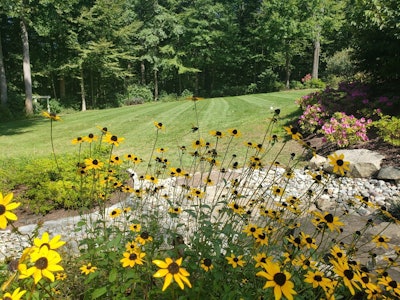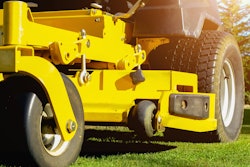
Native plants may feel a lot like a buzzword right now, but they are truly important when it comes to sustainable landscaping. You can do a lot of good for your local ecosystem as well as your clients by installing native plants.
Native plants are those that are found naturally in a particular region and are therefore adapted to the local conditions. Besides looking great, they can also help to improve the environment and help your clients meet their eco-friendly goals.
Here at Rossen Landscape in Northern Virginia, some of my favorite choices include showy coreopsis, vibrant cinnamon fern, and crimson winterberry. But there are many others to choose from. Here are four reasons that I love using native plants and that your clients will appreciate.
1. Native plants are good for the environment
One of the factors that makes native plants so eco-friendly is that they require less care. They thrive in the existing local soil, need less water, and can withstand weather conditions. They also experience fewer pest and disease problems than other non-native species.
Native plants are also a food source and habitat for local wildlife including native insects, pollinators, and others. Clients appreciate that they are doing something good for their local ecosystem by having native plants installed.
2. Native plants serve valuable purposes (like other plants)
Of course, native plants can also serve valuable functions that other plant material is desirable for like improving privacy or cutting down on noise. It's important that your clients know that native plants are more than just good for the environment. They're good for their landscape needs, too.
As an example, a strategically installed native plant can create a sight and noise buffer between your client’s home and their neighbor’s. This can help you to give your clients the privacy they desire.
3. Native plants preserve local water sources
Because they are adapted to the region, native plant roots tend to run deeper than other plant material. This is good because it assists in maintaining healthy soil, preventing erosion, managing rainwater runoff, and preventing soil compaction. These are all important elements when it comes to a sustainable landscape.
In our region, soil erosion is a particular threat because so many rely on well water and take great pride in our local waterways (like the Potomac River). But erosion can cause sediment in rovers and streams and increase pollution. Clients appreciate that our propensity toward using native plant material helps make a difference to local waterways.
4. Native plants are beautiful
Finally, I would be remiss in failing to mention that native plants are also quite beautiful. Oftentimes, when people hear the term native plant, they picture a simple wildflower garden. But that’s not the only look your clients can achieve. There are native flowers, trees, and shrubs in a diverse array of colors, patterns, and textures.
Helping your clients make native plant choices
Sustainable landscaping plants can serve a valuable role in your clients’ backyards and gardens. By helping them to choose native plant material you can create a landscape that they can feel good about while also accomplishing all of their goals.










